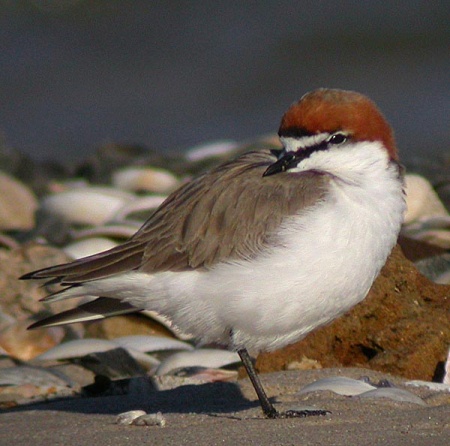(Photo caption. Corrected User Template) |
(Pictures of female and flight. Basic tidy-up. Some extra info. References. ABID & OBI links deleted. Incomplete gone) |
||
| Line 1: | Line 1: | ||
| − | {{ | + | [[Image:Red-capped_Plover.jpg|thumb|450px|right|Male<br />photo by {{user|Neil|Neil Fifer}}<br />Sydney, [[Australia]]<!--EDiTORS: This image does not appear in the Gallery-->]] |
;[[:Category:Charadrius|Charadrius]] ruficapillus | ;[[:Category:Charadrius|Charadrius]] ruficapillus | ||
| − | + | ||
==Identification== | ==Identification== | ||
| − | + | 14–16 cm (5½-6¼ in); a small plover | |
| − | + | *White body | |
| + | *Brown wings | ||
| + | *Reddish-brown cap | ||
| + | *Dark eye stripe, [[Topography#Heads|lores]] and frontal bar | ||
| + | *White [[Topography#Heads|supercilium]] | ||
| + | The female is similar, but the cap is much diminished to just a brow and reddish-brown tints around the face. | ||
| + | |||
==Distribution== | ==Distribution== | ||
| + | [[Image:Thumb IMG 4319 1024.jpg|thumb|350px|right|Female<br />Photo by {{user|aussiebirdo11|aussiebirdo11}}<br />Kalgoorlie, [[Western Australia]], August 2016]] | ||
Throughout [[Australia]] (except arid areas) and [[Tasmania]]. | Throughout [[Australia]] (except arid areas) and [[Tasmania]]. | ||
==Taxonomy== | ==Taxonomy== | ||
| − | + | This is a [[Dictionary_M-S#M|monotypic]] species<sup>[[#References|[1]]]</sup>. | |
==Habitat== | ==Habitat== | ||
| − | + | Mostly coastal; found on sandy/shell beaches with nearby mudflts. River edges and lakes inland. | |
==Behaviour== | ==Behaviour== | ||
| + | ====Breeding==== | ||
Breeds Sep. - Jan. Nest depression in soil or sand lined with shell, stones or vegetation. Eggs 2-3 pale green spotted. | Breeds Sep. - Jan. Nest depression in soil or sand lined with shell, stones or vegetation. Eggs 2-3 pale green spotted. | ||
| − | + | ====Diet==== | |
| − | Diet | + | [[Image:1568rc plover flightDSC 00731 Resized.jpg|thumb|350px|right|Flight<br />Photo by {{user|Neil|Neil}}<br />Sydney, [[Australia]], September 2004]] |
| + | Diet consists of insects larvae, small crustaceans also some seeds. | ||
| + | ====Vocalisation==== | ||
| + | '''Voice'': a sharp ''tink'' and faint trills. | ||
| + | ==References== | ||
| + | #{{Ref-Clements6thAug16}}#Handbook of the Birds of the World Alive (retrieved August 2016) | ||
| + | {{ref}} | ||
==External Links== | ==External Links== | ||
{{GSearch|Charadrius+ruficapillus}} | {{GSearch|Charadrius+ruficapillus}} | ||
| − | + | ||
| − | |||
[[Category:Birds]][[Category:Charadrius]] | [[Category:Birds]][[Category:Charadrius]] | ||
Revision as of 23:56, 12 August 2016
- Charadrius ruficapillus
Identification
14–16 cm (5½-6¼ in); a small plover
- White body
- Brown wings
- Reddish-brown cap
- Dark eye stripe, lores and frontal bar
- White supercilium
The female is similar, but the cap is much diminished to just a brow and reddish-brown tints around the face.
Distribution
Throughout Australia (except arid areas) and Tasmania.
Taxonomy
This is a monotypic species[1].
Habitat
Mostly coastal; found on sandy/shell beaches with nearby mudflts. River edges and lakes inland.
Behaviour
Breeding
Breeds Sep. - Jan. Nest depression in soil or sand lined with shell, stones or vegetation. Eggs 2-3 pale green spotted.
Diet
Diet consists of insects larvae, small crustaceans also some seeds.
Vocalisation
'Voice: a sharp tink and faint trills.
References
- Clements, J. F., T. S. Schulenberg, M. J. Iliff, D. Roberson, T. A. Fredericks, B. L. Sullivan, and C. L. Wood. 2016. The eBird/Clements checklist of birds of the world: v2016, with updates to August 2016. Downloaded from http://www.birds.cornell.edu/clementschecklist/download/
- Handbook of the Birds of the World Alive (retrieved August 2016)
Recommended Citation
- BirdForum Opus contributors. (2024) Red-capped Plover. In: BirdForum, the forum for wild birds and birding. Retrieved 27 May 2024 from https://www.birdforum.net/opus/Red-capped_Plover






